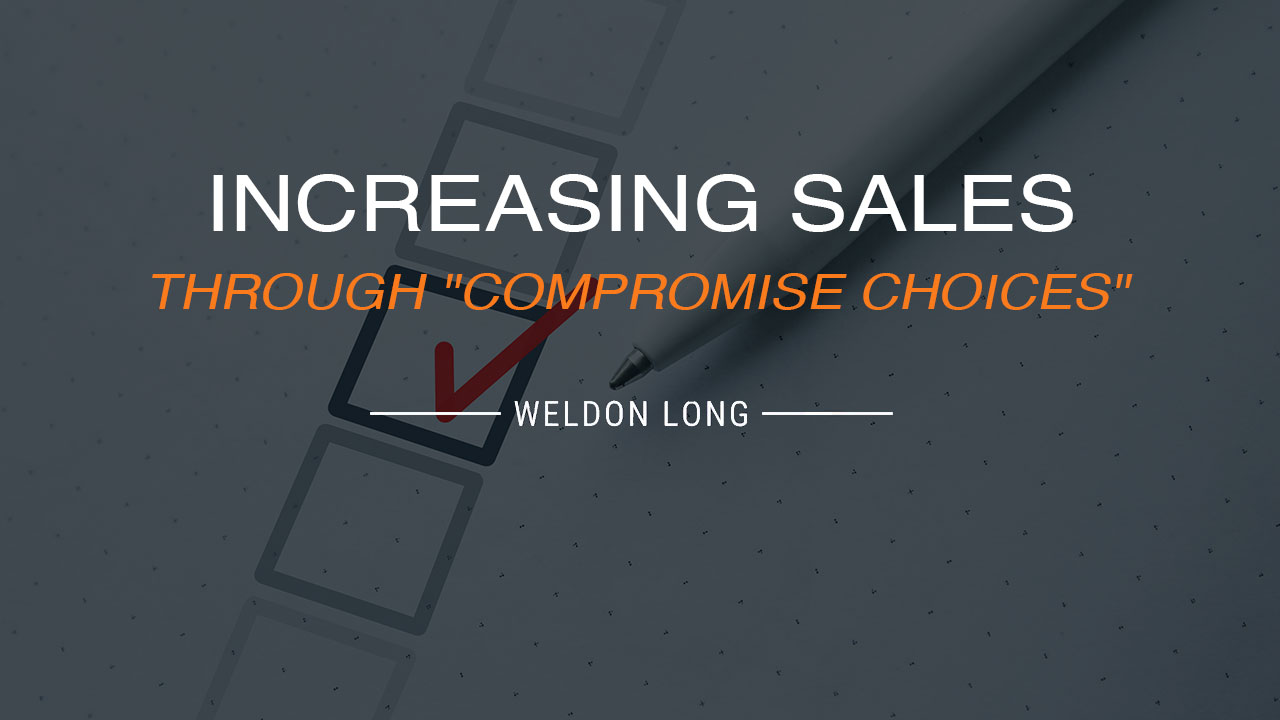Increasing Sales Through “Compromise Choices”
January 18, 2024
We’ve all heard of making compromises where two parties meet halfway, but what is meant by “compromise choices” in the world of business? Compromise choices are exactly what they sound like. It’s the tendency for human beings, for buyers, to go to the middle option. They rarely buy the most expensive of something; they rarely buy the cheapest of something, they usually buy in the middle.
I don’t mean for all items. If we see twin items (two items, same brand, same model) in two different stores, we usually try to save money and purchase the one that costs the least. Think sale at Target or the like. But for items that appear to be lowest quality, middle quality, and highest quality, research shows we land in the middle most often.As a business, this means that we have to offer multiple products and multiple solutions. Let me explain what I mean.
Not What We Expected
There’s a very famous kitchenware store called Williams Sonoma. They’re in all the high-end malls across the country, and they sell very high-end kitchenware. They have pots and pans, various silverware, utensils, etc. Well, a number of years ago, they decided that they wanted to offer a bread-baking oven to their customers. So they went out, and they found a very high-quality bread-baking oven. It was high-value but they were able to acquire it at a reasonable cost, so they offered it to their customers at a reasonable price also.
The hypothesis was that these were going to sell like hotcakes. Who wouldn’t want high quality for a good price? Well, as it turns out, they couldn’t give them away. People weren’t buying them.
One day in a meeting, the oven sales were brought up. The management concluded that maybe the type of customers we have don’t expect great prices for our products. Maybe they think that with a reasonable price, it must not be that good, or that chic, so to speak.
So they found another oven from a different vendor and decided to sell it instead. It was a much more expensive oven, and they began to swap out the inventory in all their stores. Well, some of the stores accidentally kept both bread-baking ovens on the shelves, the old one that didn’t sell, along with the new one.
And what do you suppose happened at those stores?
All of a sudden, the less expensive ones started selling out, the ones they couldn’t give away at first. Why? Because of compromise choices.
Binary = Buy Nary
You see, when you give a customer, your homeowner, only one choice, you’re actually giving them an all-or-nothing choice. They have to buy the whole thing or nothing at all. And you don’t want to give your homeowners a yes-or-no choice. You want to give them a this-or-that choice to make.
Instead of a question like, “Do you want to buy my product at this price?” you want to give them more than the binary choice of yes or no. You want to ask, “Which of these options do you think fits you the best?” The bottom line is that you have to offer compromise choices.
So this is why it’s very important, whether you’re a service technician or a comfort advisor, you have to make multiple recommendations to your homeowner, from basic systems or basic repairs on up to the most comprehensive, most expensive solutions. And you want to have four, five, or six choices. On my sales calls on my sales team, we have seven.
And guess what? Most people settle right into the two systems in the middle, which are kind of our wheelhouse systems for our average ticket in our market here. So you want to make sure and offer at least three or four service options, right? You can do basic repair as the first option, and then one level up, another level up, another level up, etc., and they’ll settle in the middle somewhere. If you give them one option, then the compromise is a big fat no, right? The same thing is true in car sales and many other industries.
Ruby Tuesday at 3 p.m.
Offer multiple options. And for you CSRs out there, this applies to you too.
When you talk to a homeowner about a service call or a sales call, you don’t want to say, “Would you like to get this set up for an appointment?” Because you’re giving them a yes-or-no decision to make, a yes-or-no option. What you want to say is, “Mr. Homeowner, we’ve got appointments on Tuesday, Thursday, and Friday; which one works better for you?” Make them choose from one of those three options rather than making them say yes or no to one offer. This is a form of an assumed close when you give them only a yes choice to make; you’re just letting them choose a Tuesday yes, a Thursday yes, or a Friday yes. See what I mean?
Compromise choices are critically important when it comes down to increasing your average ticket and selling the mid-range solutions. And just because you’ve sized up a customer thinking you know what they’ll buy, don’t skip out on offering the expensive option either. I can’t tell you how many customers ended up surprising me early in my career with a yes to the costly unit. People will spend the most on what they believe to be a long-lasting, quality product. Even if they drive a cheap car, some of them put their money where their mouths are when it comes to a major home improvement or solution.
Compromise choices. It’s part of human nature.
You do it when you shop too. I guarantee you, we all do. So give them multiple options, and you’ll find yourself leveraging compromise choices and you’ll sell higher ticket averages than ever.


